| Volume
76
July 2002
Part One: The Puerto Escondido/Loreto Cruising Grounds
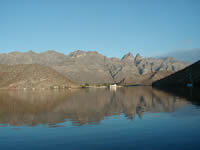 The
Two Captains have just wound up a whole month exploring the cruising
grounds of Puerto Escondido and Loreto, a XX stretch of water that
mostly closely resembles the rich selection of anchorages and activities
we were used to back home in the Virgin Islands. The territory officially
includes Agua Verde, Isla Monserrat, and the Candeleros (already
covered in Updates #73, 74 & 75), as well as San Juanico, 20
miles yet to the north of us. In between are Isla Danzante, Isla
Carmen, Isla Coronados as well as several anchorages on Baja itself.
If one were going to base a charter business in Baja, this is where
you would want to do it. Of course, now that we aren’t charging
for visitors, we failed to sign up a single taker! The
Two Captains have just wound up a whole month exploring the cruising
grounds of Puerto Escondido and Loreto, a XX stretch of water that
mostly closely resembles the rich selection of anchorages and activities
we were used to back home in the Virgin Islands. The territory officially
includes Agua Verde, Isla Monserrat, and the Candeleros (already
covered in Updates #73, 74 & 75), as well as San Juanico, 20
miles yet to the north of us. In between are Isla Danzante, Isla
Carmen, Isla Coronados as well as several anchorages on Baja itself.
If one were going to base a charter business in Baja, this is where
you would want to do it. Of course, now that we aren’t charging
for visitors, we failed to sign up a single taker!
Looking ahead, from Puerto
Escondido, It seemed like a sensible idea to try to collect all
these anchorages in one umbrella Update, but in retrospect it has
become an unwieldy job thanks to extent of our adventures here,
so we will break this up into three parts!
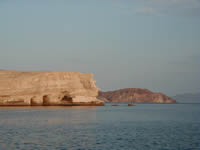 We
arrived in Puerto Escondido just in time for Fourth of July, a holiday
that Americans hate giving up even when far from home. As mentioned
in the last “Update”, Puerto Escondido is one of those
ideal creations of nature, a bay completely encircled by land but
for a 60’ wide access channel. As a harbor, it is hard to
imagine better, and for decades it has drawn sailors to its security.
Fonatur, the Mexican tourism agency, had fantasies of an extensive
marina and condo development here as part of their “stairway
to Mexico” chain of marinas, and the infrastructure was laid
maybe twenty years ago. Exactly when and why it stalled, is not
clear, but surely has to do with the fact that Loreto, the closest
city, is twenty miles to the north. I’m guessing, too, that
the resident population, while they wouldn’t mind the services
of a marina, would resist the costs of those amenities, when life
is pretty good without them. So, currently the network of paved
roads is overgrown with brush, the forest of streetlamps don’t
come on, and the seawalls remains without docks. We
arrived in Puerto Escondido just in time for Fourth of July, a holiday
that Americans hate giving up even when far from home. As mentioned
in the last “Update”, Puerto Escondido is one of those
ideal creations of nature, a bay completely encircled by land but
for a 60’ wide access channel. As a harbor, it is hard to
imagine better, and for decades it has drawn sailors to its security.
Fonatur, the Mexican tourism agency, had fantasies of an extensive
marina and condo development here as part of their “stairway
to Mexico” chain of marinas, and the infrastructure was laid
maybe twenty years ago. Exactly when and why it stalled, is not
clear, but surely has to do with the fact that Loreto, the closest
city, is twenty miles to the north. I’m guessing, too, that
the resident population, while they wouldn’t mind the services
of a marina, would resist the costs of those amenities, when life
is pretty good without them. So, currently the network of paved
roads is overgrown with brush, the forest of streetlamps don’t
come on, and the seawalls remains without docks.
As often happens
in such attractive and protected anchorages, more and more anchors
get “permanently set”. Puerto Escondido is well populated
with boats that haven’t moved in memory. Some of these are
just stored here, but many others have fulltime folks living aboard.
There is also a contingent of land-based “campers.”
Many of these are quasi permanent, with RVs or trailers shaded by
palapas, that grow more and more elaborate over time. One we visited
had full living room furniture, a regular kitchen, and – their
special pride and joy – a complete, enclosed modern bathroom!
This in open-walled structures with thatch roofs!! Some of these
folks came originally as cruisers, while others came for the fishing.
So with all
these gringos at hand, Puerto Escondido was a good place for the
Fourth. The main event was a potluck picnic at a special park called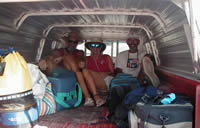 Agua Primera. This park was back in the hills in an arroyo oasis
created by a natural spring. Three hundred years or so ago, the
missionaries built a swimming pool in the arroyo and this is still
in operation. Well, sort of. Despite a “reservation”,
the gringos trickled in by carpool to find that the maintenance
crew had drained the pool to clean it!!! This was surely a disappointment,
but not so great a one as to destroy the occasion. The picnic fare
was scrumptious and the arroyo was thickly shaded with mango trees
heavy with fruit. No one left without a stash! That evening we motored
out of Puerto Escondido around to Juncalito, a lovely, more open
anchorage to the north where the camper contingent put of a very
nice, albeit small scale, fireworks on the beach. All in all a nice
day.
Agua Primera. This park was back in the hills in an arroyo oasis
created by a natural spring. Three hundred years or so ago, the
missionaries built a swimming pool in the arroyo and this is still
in operation. Well, sort of. Despite a “reservation”,
the gringos trickled in by carpool to find that the maintenance
crew had drained the pool to clean it!!! This was surely a disappointment,
but not so great a one as to destroy the occasion. The picnic fare
was scrumptious and the arroyo was thickly shaded with mango trees
heavy with fruit. No one left without a stash! That evening we motored
out of Puerto Escondido around to Juncalito, a lovely, more open
anchorage to the north where the camper contingent put of a very
nice, albeit small scale, fireworks on the beach. All in all a nice
day.
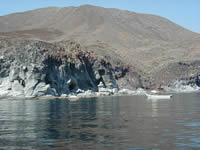 The
next day, we motored north to Loreto to do all the official stuff
with the Port Captain there. Loreto, amazingly, is Baja’s
oldest city. In 1697, Father Juan Salvatierra established the Mission
Nuestra Senora de Loreto, the first mission on Baja from where in
1799 was launched the establishment of all the famous missions of,
what is called in these parts, Alta California. Loreto is a pleasant
town with an “international airport” (i.e. flights to
California!!!!), although there seems to be way more facilities
built than it is currently supporting. From a cruiser’s point
of view, the town’s biggest shortcoming is no protected anchorage.
A big seawall enclosed an area for the fishing pangas, but sailboats
are relegated to dropping the hook in the open-roadstead outside.
The day we came in was dead calm when we arrived, but by midday
a hefty swell had kicked up, so that after paperwork, reprovisioning
(great vegetable/fruit stand), and tasting all the options at McLulul’s
Taco Stand, we beat a hasty retreat for a more protected overnight
anchorage. The
next day, we motored north to Loreto to do all the official stuff
with the Port Captain there. Loreto, amazingly, is Baja’s
oldest city. In 1697, Father Juan Salvatierra established the Mission
Nuestra Senora de Loreto, the first mission on Baja from where in
1799 was launched the establishment of all the famous missions of,
what is called in these parts, Alta California. Loreto is a pleasant
town with an “international airport” (i.e. flights to
California!!!!), although there seems to be way more facilities
built than it is currently supporting. From a cruiser’s point
of view, the town’s biggest shortcoming is no protected anchorage.
A big seawall enclosed an area for the fishing pangas, but sailboats
are relegated to dropping the hook in the open-roadstead outside.
The day we came in was dead calm when we arrived, but by midday
a hefty swell had kicked up, so that after paperwork, reprovisioning
(great vegetable/fruit stand), and tasting all the options at McLulul’s
Taco Stand, we beat a hasty retreat for a more protected overnight
anchorage.
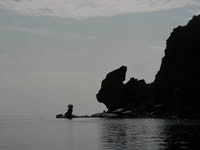 This
was our first introduction to Isla Coronados, named for its volcanic
peak. There is nothing not to like about Isla Coronados. We arrived
in tandem with our friends on Lady Galadriel, to a wide-open empty
anchorage with a long stretch of sandy beach and a protective hook
curving around to the south. Almost immediately we were surrounded
by dolphins. There were several pods that through the course of
our multi-day stay busily worked the waters, leaping and snorting
and slapping their tails (or whole bodies), often quite close to
the boats, apparently herding fish. This was what we imagined we’d
see in the Sea, and we did not tire of watching their antics. At
night the bioluminescence was fantastic, while the channel between
us and the “mainland” was lit up with such a string
of lights that you’d be persuaded there was civilization over
there, but was in fact the squid fishermen at their nights work This
was our first introduction to Isla Coronados, named for its volcanic
peak. There is nothing not to like about Isla Coronados. We arrived
in tandem with our friends on Lady Galadriel, to a wide-open empty
anchorage with a long stretch of sandy beach and a protective hook
curving around to the south. Almost immediately we were surrounded
by dolphins. There were several pods that through the course of
our multi-day stay busily worked the waters, leaping and snorting
and slapping their tails (or whole bodies), often quite close to
the boats, apparently herding fish. This was what we imagined we’d
see in the Sea, and we did not tire of watching their antics. At
night the bioluminescence was fantastic, while the channel between
us and the “mainland” was lit up with such a string
of lights that you’d be persuaded there was civilization over
there, but was in fact the squid fishermen at their nights work
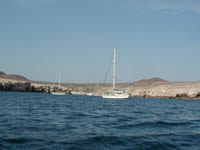 Dennis
and Lisa of Lady Galadriel were also divers, so at last the two
captains broke out our dive gear and made our Sea of Cortez diving
debut enjoying several sites at the base of some elaborate rock
formations on the island’s north side. The water was still
quite cool, in the low 70s, so we were grateful for our 5mm wetsuits
and neoprene hoods we’d never worn before, but the visibility
was pretty decent. The boys were especially delighted by thick populations
of large, meaty fish from cabrilla (grouper-types) to yellowtail,
while the ladies enjoyed such smaller and more delicate creatures
as nudibranchs and snake eels. The 2Cs can’t get over the
huge variety of fleshy starfish, something we have relatively few
of in the Virgins, not to mention the multitude of huge green moray
eels! And if the diving weren’t enough, the kayaking was delightful,
especially with the dolphins making passes. Plus, the white sand
beach was a superb place to spend time sitting waist deep in the
late afternoons, sifting your fingers through sand to reveal a whole
rainbow of tiny clams the size of your thumbnail. Dennis
and Lisa of Lady Galadriel were also divers, so at last the two
captains broke out our dive gear and made our Sea of Cortez diving
debut enjoying several sites at the base of some elaborate rock
formations on the island’s north side. The water was still
quite cool, in the low 70s, so we were grateful for our 5mm wetsuits
and neoprene hoods we’d never worn before, but the visibility
was pretty decent. The boys were especially delighted by thick populations
of large, meaty fish from cabrilla (grouper-types) to yellowtail,
while the ladies enjoyed such smaller and more delicate creatures
as nudibranchs and snake eels. The 2Cs can’t get over the
huge variety of fleshy starfish, something we have relatively few
of in the Virgins, not to mention the multitude of huge green moray
eels! And if the diving weren’t enough, the kayaking was delightful,
especially with the dolphins making passes. Plus, the white sand
beach was a superb place to spend time sitting waist deep in the
late afternoons, sifting your fingers through sand to reveal a whole
rainbow of tiny clams the size of your thumbnail.
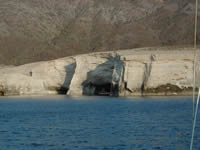 We
parted company from Lady Galadriel at Coronados and motored through
flat water punctuated by the exciting shapes of finback whales about
thirteen miles east to the north side of Isla Carmen, a seventeen-mile
long island opposite Loreto. Here we found a group of cruising yachts
squeezed into a really unusual anchorage called Vee Cove, despite
the fact that the cruising guide calls it a one-boat spot. The fact
is, if the wind direction is such that you can anchor there at all,
then there no reason more boats can’t stack up outside the
cove. Vee Cove looks just like someone cut a pie wedges out of the
30-40’ high cliffs. These whitish cliffs are elaborately eroded
into caves and undercuts that just beg kayaking, which I did within
an hour of dropping the hook in tandem with Katherine of The Good
Neighbor. Later that evening there was a happy hour dinghy raftup
inside the largest of the caves! One doesn’t want to spend
a lot of time thinking about what holds up the ceilings of these
caves! We
parted company from Lady Galadriel at Coronados and motored through
flat water punctuated by the exciting shapes of finback whales about
thirteen miles east to the north side of Isla Carmen, a seventeen-mile
long island opposite Loreto. Here we found a group of cruising yachts
squeezed into a really unusual anchorage called Vee Cove, despite
the fact that the cruising guide calls it a one-boat spot. The fact
is, if the wind direction is such that you can anchor there at all,
then there no reason more boats can’t stack up outside the
cove. Vee Cove looks just like someone cut a pie wedges out of the
30-40’ high cliffs. These whitish cliffs are elaborately eroded
into caves and undercuts that just beg kayaking, which I did within
an hour of dropping the hook in tandem with Katherine of The Good
Neighbor. Later that evening there was a happy hour dinghy raftup
inside the largest of the caves! One doesn’t want to spend
a lot of time thinking about what holds up the ceilings of these
caves!
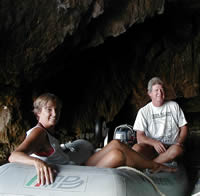 Unfortunately,
when we went snorkeling the next day, we discovered that a bloom
of nasty stingers aptly called “String of Pearls” was
moving through. Even with wetsuits, gloves, socks and hoods, these
little threads of pain would find a bit of open skin and leave a
whopper of a welt. So it was without much regret that when the wind
clocked around the north, we all sailed off other anchorages. Unfortunately,
when we went snorkeling the next day, we discovered that a bloom
of nasty stingers aptly called “String of Pearls” was
moving through. Even with wetsuits, gloves, socks and hoods, these
little threads of pain would find a bit of open skin and leave a
whopper of a welt. So it was without much regret that when the wind
clocked around the north, we all sailed off other anchorages.
We chose Puerto Ballandra,
a perfectly protected anchorage situated on Carmen’s NW coast
directly across from Loreto. This makes it a popular stop for many
boats, so we never had it to ourselves, plus we found the nearby
reefs to be pretty well picked over for fish for dinner. We tried
a dive on an islet to the north called Isla Cholla with Alan of
The Good Neighbor, but aborted the dive when confronted with thick
stingers flying along in a stiff current! Instead we used our tanks
up enjoying a mild midday stroll on some shallow boulders just the
north of the anchorage itself.
Looking for better hunting,
we moved south to Bahia Marquer, where we had heard fishing was
good. Here we stumbled into another group of avid divers, led by
the famous Terry Kennedy on his trimaran Manta. Terry is one of
those well-known characters who seems to live to dive. A former
Navy Seal, he has been diving the Sea for 26 years, and he knows
all the special places and enjoys sharing them. We had referrals
from many of the cruisers we met in Panama and Costa Rica to look
Terry up aboard his trimaran Manta when we got here, so it seemed
providential to finally meet up with him just as we were getting
back into diving.
Providential
or not is something we will debate for a long time.
|